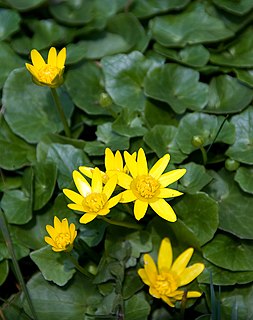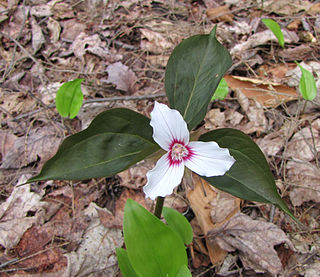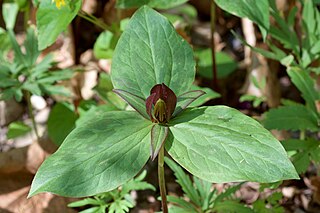
Trillium is a genus of about fifty flowering plant species in the family Melanthiaceae. Trillium species are native to temperate regions of North America and Asia, with the greatest diversity of species found in the southern Appalachian Mountains in the southeastern United States.

Ficaria verna, commonly known as lesser celandine or pilewort, is a low-growing, hairless perennial flowering plant in the buttercup family Ranunculaceae native to Europe and west Asia. It has fleshy dark green, heart-shaped leaves and distinctive flowers with bright yellow, glossy petals. It is now introduced in North America, where it is known by the common name fig buttercup and considered an invasive species. The plant is poisonous if ingested raw and potentially fatal to grazing animals and livestock such as horses, cattle, and sheep. For these reasons, several US states have banned the plant or listed it as a noxious weed. It prefers bare, damp ground and is considered by horticulturalists in the United Kingdom as a persistent garden weed; nevertheless, many specialist plantsmen, nursery owners and discerning gardeners in the UK and Europe collect selected cultivars of the plant, including bronze-leaved and double-flowered ones. Emerging in late winter with flowers appearing March through May in the UK, its appearance across the landscape is regarded by many as a harbinger of spring.

Trillium grandiflorum is a species of flowering plant in the family Melanthiaceae. A monocotyledonous, herbaceous perennial, the plant is native to eastern North America, from northern Quebec to the southern parts of the United States through the Appalachian Mountains into northernmost Georgia and west to Minnesota. There are also several isolated populations in Nova Scotia, Maine, southern Illinois, and Iowa.

Rubus parviflorus, commonly called thimbleberry, is a species of Rubus native to northern temperate regions of North America. It bears edible red fruit similar in appearance to a raspberry, but shorter, almost hemispherical. Because the fruit does not hold together well, it has not been commercially developed for the retail berry market, but is cultivated for landscapes. The plant has large hairy leaves and no thorns.

The Connecticut College Arboretum is a 300 ha arboretum and botanical gardens, founded in 1931, and located on the campus of Connecticut College and in the towns of New London and Waterford, Connecticut, United States.

Maianthemum racemosum is a species of flowering plant native to North America. It is a common, widespread plant known from every US state except Hawaii, and from every Canadian province and territory except Nunavut, as well as from Mexico.

Eustoma, commonly known as lisianthus or prairie gentian, is a small genus in the gentian family. They are native to warm regions of the southern United States, Mexico, Caribbean and northern South America. This genus is typically found in grasslands and in areas of disturbed ground.

Uvularia grandiflora, the large-flowered bellwort or merrybells, is a species of flowering plant in the family Colchicaceae, native to eastern and central North America.

Trillium ovatum, the Pacific trillium, also known as the western wakerobin, western white trillium, or western trillium, is a species of flowering plant in the family Melanthiaceae. It is found in western North America, from southern British Columbia and the tip of southwestern Alberta to central California, east to Idaho and western Montana. There is an isolated population in northern Colorado and southern Wyoming.

Trillium undulatum, the painted trillium, is a species of flowering plant in the family Melanthiaceae. It is also known as painted lady, smiling wake robin, or trille ondulé in French. The plant is found from Ontario in the north to northern Georgia in the south and from Michigan in the west to Nova Scotia in the east. It demands strongly acidic, humus-rich soils and tends to be found in the shade of acid-loving trees such as eastern white pine, red maple, red spruce and balsam fir. Although the soils that support it have low base saturation, this species was found to have relatively high levels of calcium, magnesium, and especially potassium in its foliage.

Trillium sessile, known as toadshade, sessile trillium, sessile-flowered wake-robin, and toad trillium, is a perennial spring wildflower native to the central part of the eastern United States and the Ozarks. Toadshade can be distinguished from other Trillium species by its single, foul smelling, stalkless, flower nestled in the middle of its three bracts. The bracts are sometimes, but not always mottled with shades of light and dark green. The specific epithet comes from the Latin word sessilis which means low sitting, referring to its stalkless flower.

Eustoma russellianum, is a species of flowering plant in the gentian family. Its previous binomial name was Eustoma grandiflorum. Common names include Texas bluebells, Texas bluebell, bluebell, showy prairie gentian, prairie gentian, and Lisianthus.

Erythronium grandiflorum is a North American species of plants in the lily family. It is known by several common names, including yellow avalanche lily, glacier lily, and dogtooth fawn lily. The Ktunaxa name for glacier lily is maxa.

Maianthemum stellatum is a species of flowering plant, native across North America generally from Alaska to California to North Carolina to Newfoundland, plus northern Mexico. It has been found in every Canadian province and territory except Nunavut, and from every US state except Hawaii and the states of the Southeast. It has little white buds in the spring, followed by delicate starry flowers, then green-and-black striped berries, and finally deep red berries in the fall.

Trillium sulcatum, the furrowed wakerobin, southern red trillium or Barksdale trillium, is a perennial wildflower that blooms in April and May. It is native to the southern Appalachian Mountains and nearby areas from West Virginia to Alabama.

Trillium decumbens, also known as the decumbent trillium or trailing wakerobin, is a species of flowering plant in the family Melanthiaceae. It is native to the southeastern United States, in Tennessee, Georgia, and Alabama, growing in mature deciduous woodlands or on open rocky wooded slopes.

Trillium foetidissimum, also known as the Mississippi River wakerobin, stinking trillium, or fetid trillium, is a species of flowering plant in the family Melanthiaceae. It is found along the Louisiana–Mississippi border in a variety of habitats.
Trillium oostingii, commonly known as Wateree trillium, is a species of flowering plant in the family Melanthiaceae. It is endemic to the central part of the US State of South Carolina. Wateree trillium grows under a canopy of deciduous trees such as bitternut hickory, black walnut, slippery elm, box-elder, and various oak species, in rich floodplain soils. Here it forms large colonies alongside mayapple, another spring-flowering herb.

Mt. Cuba Center is a non-profit botanical garden located in Hockessin, Delaware, near Wilmington, in the gently rolling hills of the Delaware Piedmont. Its woodland gardens produce some of the most spectacular displays of wildflowers in the mid-Atlantic region. Mt. Cuba is open to the public from April through November for general admission, guided tours and special programs. Education courses, including a Certificate in Ecological Gardening, are offered year-round.

Pamela Cunningham Copeland was an American horticulturist and historical preservationist, known for her philanthropy. Her home and gardens became Mt. Cuba Center, a public garden and research center for Appalachian Piedmont flora that was added to the National Register of Historic Places in 2003.


















